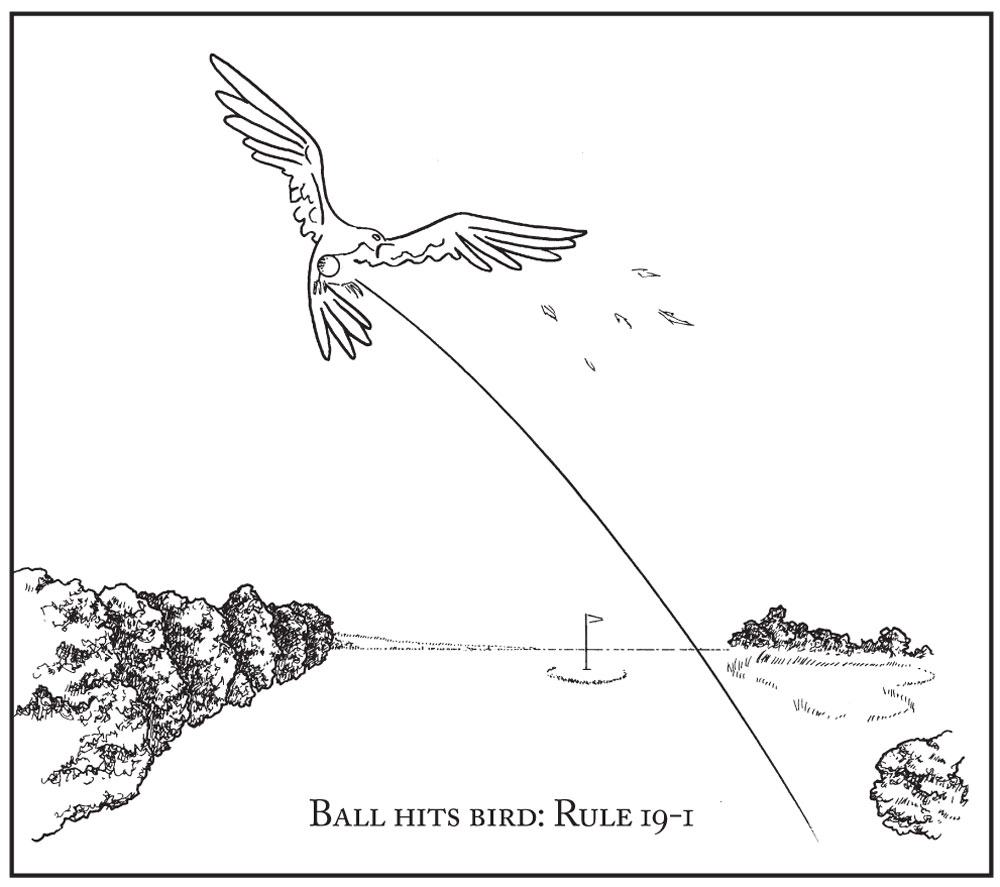
The rules referred to throughout the book are the official rules of the United States Golf Association (USGA). The rules of other national golf associations, including the Royal and Ancient Golf Club of St. Andrews, are consistent with these rules, though the wording may vary.
Subsections of rules are indicated by a dash (Rule 1-4). Official decisions interpret rules, thus Decision 1-4/9 describes the ninth decision regarding the fourth section of Rule 1.
Stroke play rules refer to tournaments that count the total number of strokes per round, which is the more common type of competition. Match play rules apply to competition in which two players go head-to-head; the lowest score on each hole wins that hole. The player who wins the most holes is the winner.
You are allowed to take 14 clubs with you during a round of golf (Rule 4-4). You can take fewer clubs if you wish and add to that number during the round only if the total never exceeds 14. Any added clubs must be yours and not lent to you from anyone on the course. You can share clubs with a partner if the total number of clubs between the two of you is not more than 14 clubs.
If you realize that you have too many clubs in your bag before the start of the round, you can remove the extra clubs. Do not place the extra clubs in your golf cart. The clubs in the golf cart will be added to the number in your bag. If the round has started and you realize you have too many clubs, you must immediately declare the clubs out of play for the remainder of the round. If you do not immediately notify your playing partners that you have more than fourteen clubs, you will be disqualified. The penalty in stroke play for too many clubs is two strokes per hole, with a maximum penalty of four strokes.

If you hit a flying bird, it is considered “a rub of the green,” also known as tough luck (Rule 19-1). You must play the ball where it lies. If the bird catches the ball in midair and carries it to the green, this is considered fair play, and you can play the ball where it lies.
If your ball lands in or near a bird’s nest, you may pick up the ball without penalty. You may not drop your ball any nearer to the hole. You must drop your ball as near as possible to the nest and in a way that would allow you to take your shot without damaging the nest. If the nest is in a hazard, you must drop your ball in the hazard (Decision 1-4/9).
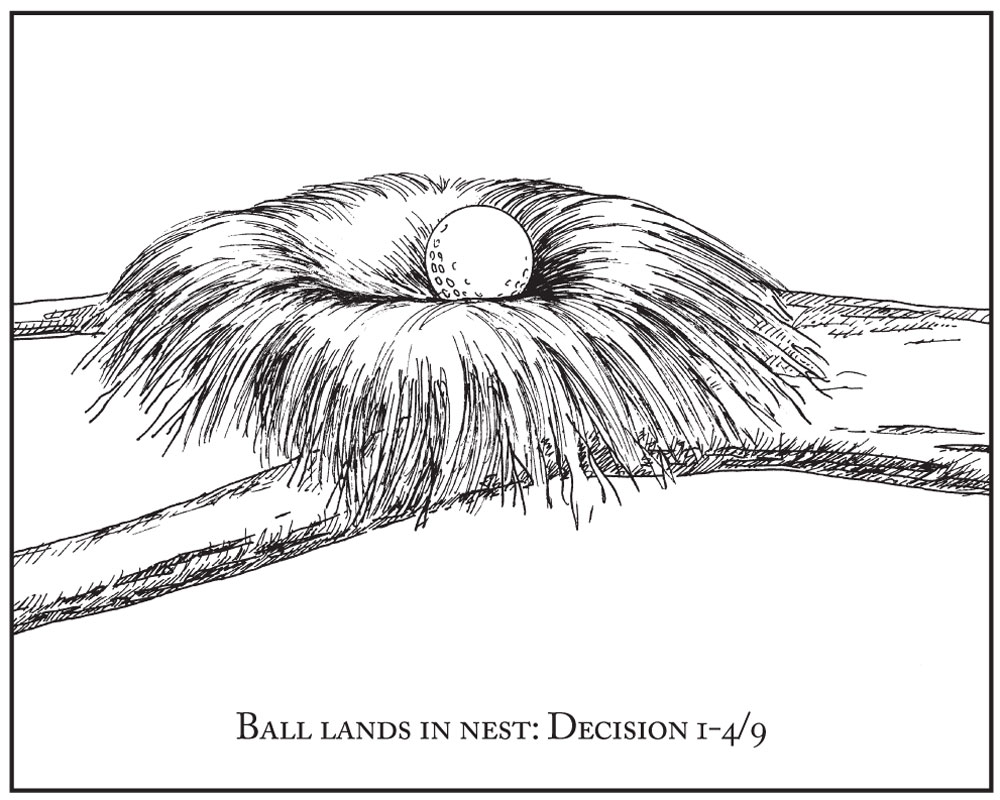
There is no such thing as using the wrong club during a round of golf. If you want to tee off with your putter, you can do so without penalty. In general, if the USGA has approved all the clubs in your bag and as long as there are fourteen or fewer clubs, you may use them as you think best.
All clubs in your bag must comply with the standards for golf clubs set by the USGA (Rule 4-1). If a golf club in your bag does not conform to the USGA standards, even if you do not use it, the penalty is disqualification of either the hole or the match.
Specifically, the rules state that you may also not use any artificial device or unusual equipment that might “assist” you in making a stroke or play (including distance gauges and measuring devices), or in gripping a club (other than plain gloves, powder, or a towel or handkerchief ).
If during stroke play your hat falls off and moves your stationary ball, you are assessed a one-stroke penalty and you must replace the ball to its original location. You are assessed one more stroke if you do not replace it (Rule 18-2).
In stroke play, there is no penalty if someone else’s hat unintentionally falls and moves your ball. You must replace the ball to its original position. You are assessed a two-stroke penalty if the ball is not replaced.
In match play there is a one-stroke penalty assessed against the player whose hat or whose caddie’s hat moves an opponent’s ball. It is a loss-of-hole penalty if the opponent does not replace the ball.
If your opponent intentionally moves his stationary ball and that movement is not sanctioned by the rules, there is a one-stroke penalty in stroke play and a loss-of-hole penalty in match play (Rule 18-2). There are many situations when a golfer is allowed to move his ball. For example, a player can move the ball to identify it if he announces his intentions and the ball is not in a hazard, or if the ball is located in an area designated as “ground under repair.”
If your ball lands in manure, you can either play it as it lies or declare it unplayable and take a free drop (Rule23). If the ball is embedded in the manure, however, there is no free relief. Even though manure is a natural object, the manure is no longer a loose impediment if it is attached to the ball. You will incur a one-stroke penalty if you declare the ball unplayable in this situation.
If your ball lands near or behind a pile of manure, you can move the manure as long as the manure is not embedded in the ground. Rule 23 states that loose impediments can be removed without penalty. Loose impediments are natural objects such as stones, leaves, twigs, branches, and dung (manure). This also includes worms and insects, and the casts or heaps made by them, provided they are not fixed or growing, are not solidly embedded, and do not adhere to the ball. Sand and loose soil are loose impediments on the putting green but not elsewhere.
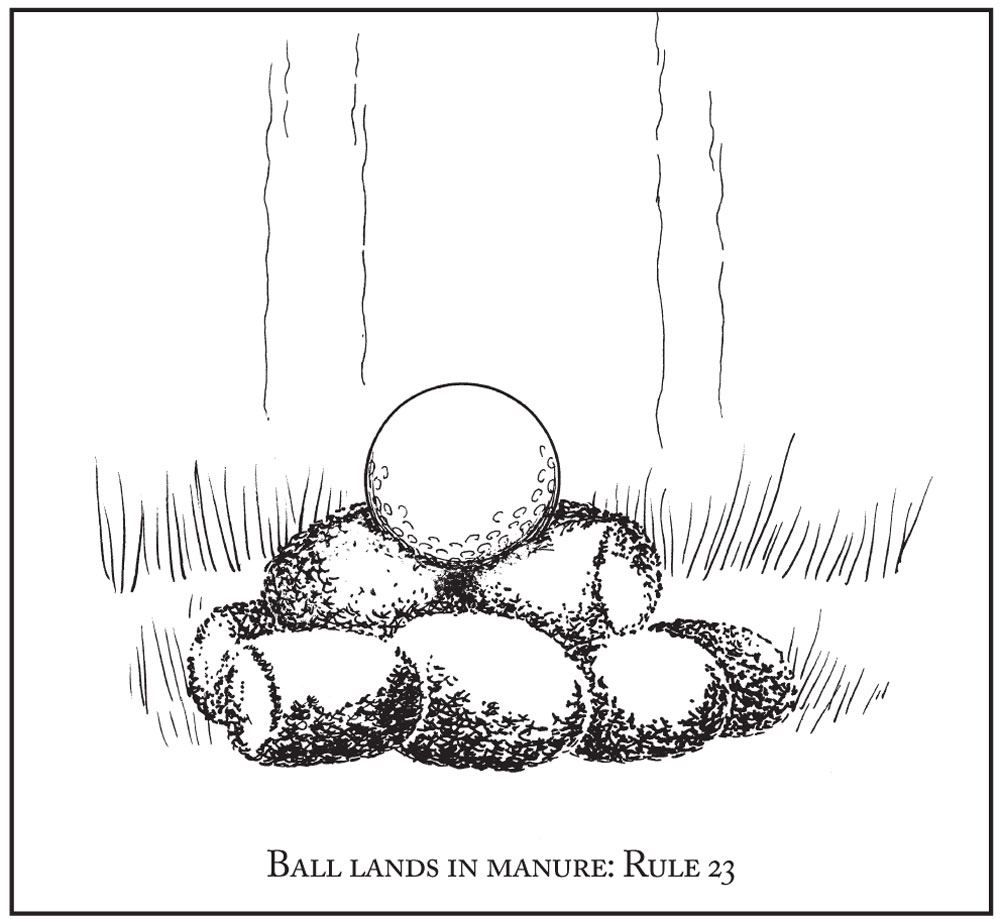
If you hit the golf ball with the top of a club grip as you would hit a pool ball with a pool cue, you will be in violation of Rule 14-1. You would be assessed a two-stroke penalty in stroke play and you would lose the hole in match play. The rule states that you must fairly strike the ball with the head of the club and not push, scrape, or spoon the ball. A pool cue shot, even if you used the head of the club, would be considered a push under the rules (Decision 14-1/2).
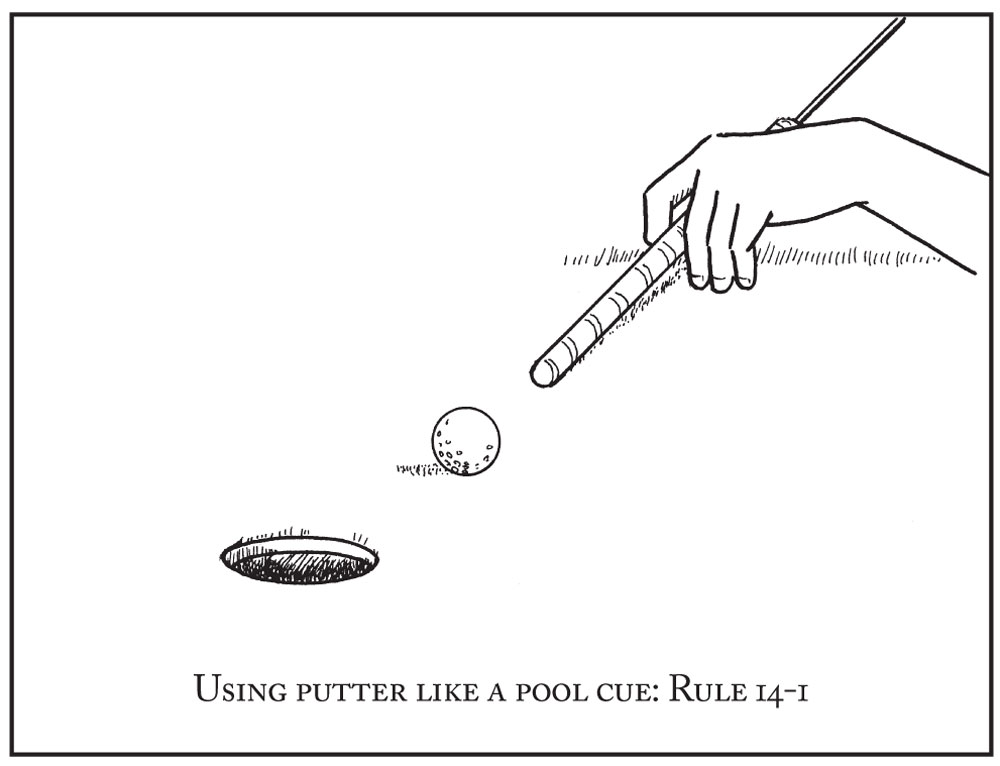
If a dog, fox, or squirrel steals your ball as it sits on the fairway, you may replace the ball at the original spot without any penalty (Rule 18-1). However, a ball moved by wind or water must be played where it ends up. A snake that moves your ball is considered an outside agency, like a dog or squirrel, but a dead snake is a loose impediment and may be moved if it is blocking your path. Make sure the snake is actually dead. If you are not sure, you can take a free drop.
When a ball has been moved by an animal and it is not clear where its original position was, the player may replace his ball without penalty in an area that provides neither an advantage nor a disadvantage by agreement with opponents (Decision 18-1/5).
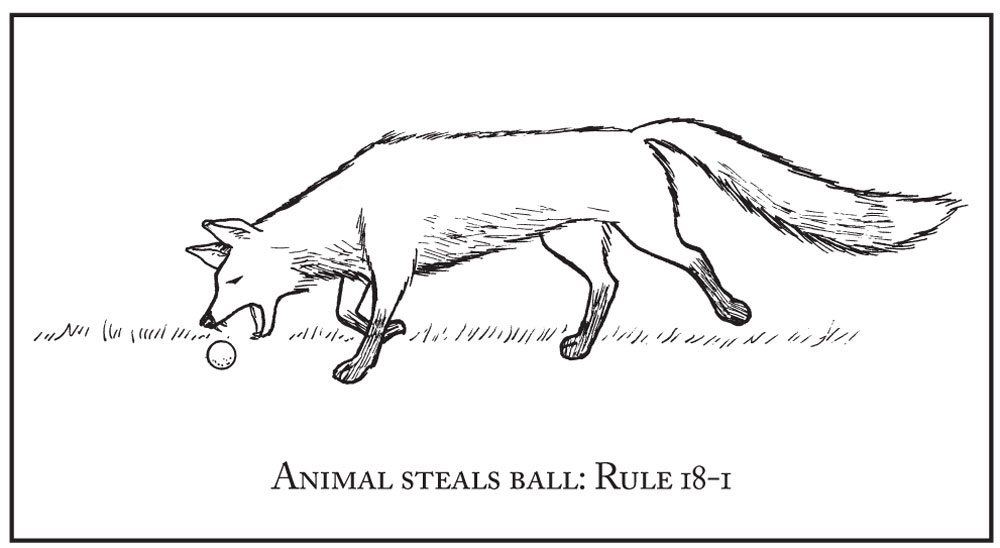
If you hit your ball onto the wrong putting green, you may not hit it off the green. There is no penalty for picking up your ball and dropping it off the green at the nearest point of relief (Rule 25-3). Drop the ball within one club-length of the nearest point of relief but no closer to your intended pin. The nearest point of relief would not include dropping it in a hazard or on the green. You may clean the ball when you lift it from the green.
The top of the ball must be below the top of the cup to be considered holed. If the ball comes to rest against the flagstick (but is not holed), the stick may be moved or removed. If the ball falls in, it is considered holed (Rule 17-4). If the ball does not fall in, the player must mark the ball at the edge of the cup. If a player pulls out the stick and the ball is moved away from the hole, that individual must replace the ball without penalty at the edge of the cup. Not replacing the ball is a two-stroke penalty in stroke play and loss-of-hole penalty in match play.
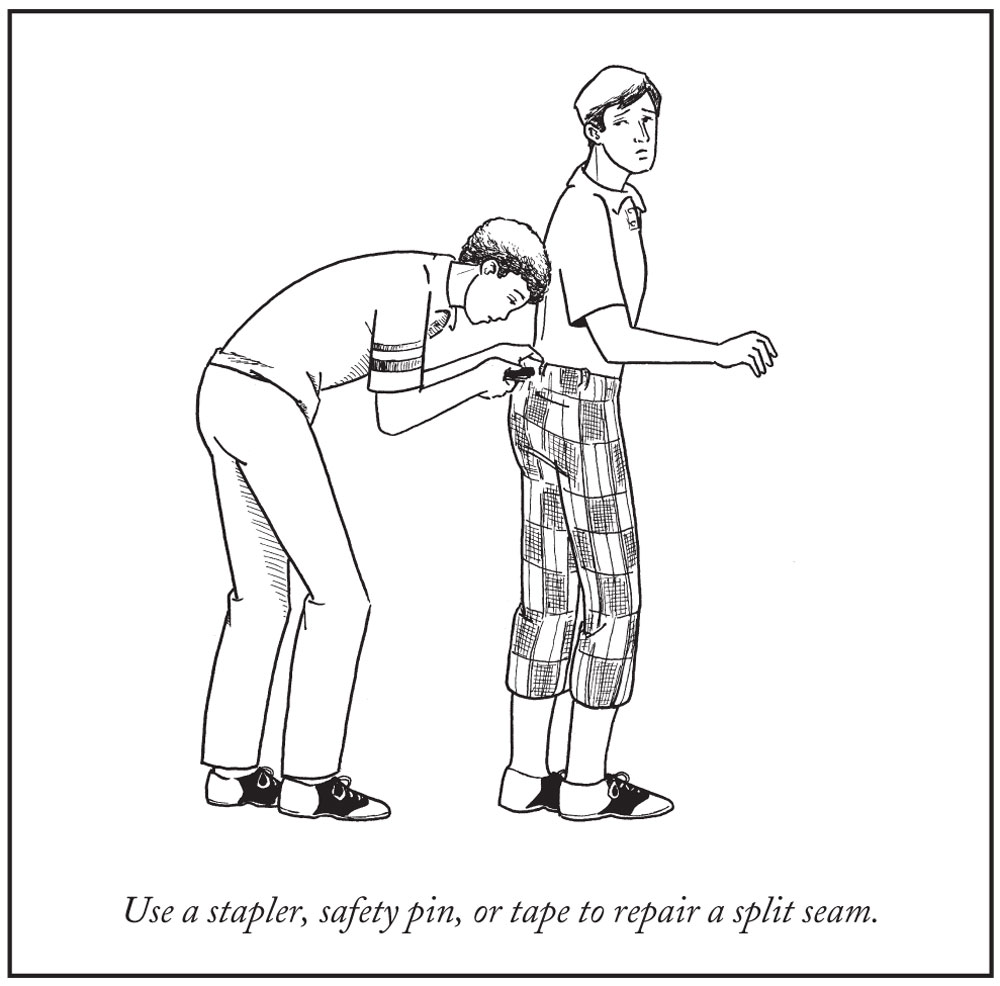
 PIN
PIN
A safety pin is the fastest, most secure way to hold a seam together. However, many golfers sport lapel pins on their jackets, and these may work in a pinch. Two or three pins in the ripped area should suffice for a temporary solution.
Staples can be used to repair seams and will not damage most fabrics, provided they are removed carefully. Take care to avoid stretching the seam; the fabric may tear around the staples if it is pulled hard. If you are on the course and have any papers with staples already in them, carefully remove the staples and re-use them on the seam. Poke the ends through the fabric and bend them in. Alternatively, the pro shop, restaurant, or clubhouse will most likely have a stapler.
 TAPE
TAPE
Apply very sticky tape to the inside of the garment to hold a seam together. Adhesive tape from a first aid kit should work, though it might mark the garment. Electrical or duct tape will work best. Grip tape for clubs may also be used, but avoid the weaker masking tape and cellophane tape.
 SQUARE KNOT
SQUARE KNOT
Tie the broken ends of the lace together using a square knot: stack two regular knots, wrapping the same strand over each time. Use the mnemonic “right over left, left over right.”
 LONGER LACE
LONGER LACE
Remove the lace and retie it using only the longer end. You may have to skip a few eyelets to have enough length to tie a knot.
If you have carried your street shoes onto the course, they may provide a lace to use in place of the broken one.
 CADDIE’S LACES
CADDIE’S LACES
If you have a caddie, try borrowing the laces from one of his shoes.
 GOLF BAG
GOLF BAG
Use a small strap or tie from your golf bag, if you have one.
 STRING OR A RUBBER BAND
STRING OR A RUBBER BAND
Tie a piece of string or a long rubber band between the two ear pieces and stretch it across the back of the head. This will prevent sunglasses from slipping down a sweaty nose.
Alternatively, two rubber bands, one on each side, can be twisted around the earpieces to increase friction and reduce slippage.
 GRIP TAPE
GRIP TAPE
Cut two small pieces of grip tape, which is sticky, and place them on the nose pads on your glasses. The tape will both absorb sweat and keep your glasses from sliding.
A small piece of tissue wedged under the nose pads should prevent slippage, but be aware that it may impair vision.
 BORROW OTHER PEOPLE’S GLASSES
BORROW OTHER PEOPLE’S GLASSES
You may be able to find a pair of glasses from someone who has a similar prescription. You can borrow them when you hit.
 SQUINT
SQUINT
Squinting actually increases your depth of field by blocking out excess rays entering the retina, allowing images that are fuzzy to become clearer.
 PINHOLE GLASSES
PINHOLE GLASSES
Pinhole glasses block out excess rays and can improve vision. Draw two circles about the size of a pair of lenses on a piece of paper or cardboard. Use a pin,
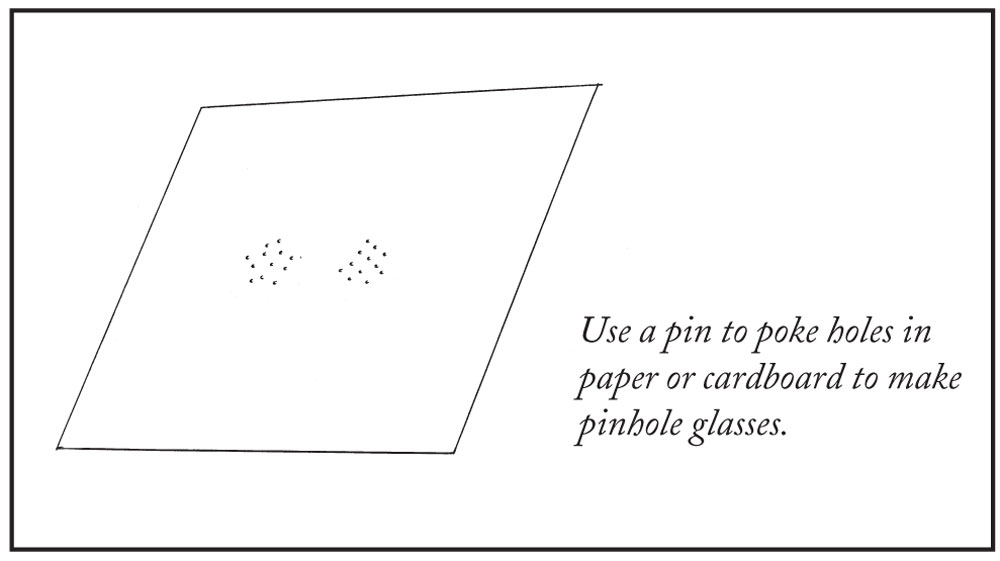
knife, or a tee to poke at least a dozen small holes in each area where you have drawn your circles. Look through your pinhole glasses to improve your vision.
Bingo Bango Bongo—Each hole is worth three points: one point for hitting the green with the fewest strokes, one point for the player closest to the pin after everyone is on the green (it doesn’t matter how many strokes it took to get there), one point for the player in the hole with the fewest number of strokes or to the first player in the hole. A monetary value is assigned to each point, and each player puts that amount in a pot. The player who has the most points at the end of the match wins the pot.
Pick-Up Sticks—Players wager a certain amount for the front nine, the back nine, and the match. Each hole a player loses gives that player the right to remove one of his opponent’s clubs from play. The clubs can be brought back into play if that player then loses a future hole (but he cannot then take his opponent’s club). Putters can be given “immunity.” The winner of each set of holes (and ultimately the match) gets the pot.
Scotch Foursome—Also known as Foursome. Two teams bet a certain amount per hole. Pairs of players alternate shots from tee to green until the ball is in the hole. One player drives even holes and putts odd, the other drives odd holes and putts even. The team who wins the match, the front nine, back nine, or the individual holes (whichever had been decided beforehand) wins the money.
Skins—Each player puts in a certain amount per hole to form a total per-hole pot, or “skin.” The player who wins the whole on a net basis (the score for that hole after adjusting for handicap) wins that hole’s pot. If any number of players tie, the pot carries over to the next hole, again carrying over until a single player wins a hole. If the 18th hole ends in a tie, the final “skin” goes to the player with the best overall score, a runoff going to the player who won the most “skins.” This gambling game is best for threesomes and foursomes.
Snake—The object of this game is to not “three-putt.” A player who “three-putts” first “holds the snake.” The snake is then held by that player until another player three-putts. At the end of the ninth and eighteenth holes, the player holding the snake must pay the other players a set amount. Combining this game with another gambling game makes life interesting—a player may hit around the green without getting on it to avoid a three-putt, but this may hurt him if another gambling game is being played at the same time.
Murphy—A player has declared a “Murphy” when he bets that he can get onto the green and into the hole in a certain number of shots.
Overs—If a player moans about his bad luck, he can be forced to take the shot again if you call an “overs” bet before the ball comes to rest. In this bet, you are betting against that player’s ability to do better. If the whiner makes a better shot, he wins. If not, you win.
Scruffy—Calling a “scruffy” is to bet that, despite a horrible tee shot, you can still make par.
Arnie—A bet that is won by scoring par without touching the fairway.
Bambi—A bet that is won by scoring par after hitting an animal.
Froggy—A bet that is won by skipping a golf ball across a water hazard.